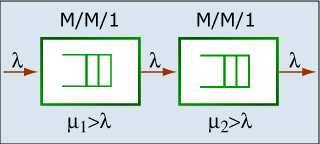
Tandem queues: A stable M/M/1 queue has a Poisson output at the input rate. The next queue also has a Poisson output at that rate. (Image by MIT OpenCourseWare, adapted from Prof. Robert Gallager's course notes.)
Instructor(s)
Prof. Robert Gallager
MIT Course Number
6.262
As Taught In
Spring 2011
Level
Graduate
Course Description
Course Features
- Video lectures
- Subtitles/transcript
- Online textbooks
- Assignments: problem sets with solutions
- Exams and solutions
Course Highlights
This course features a complete set of course notes, which provide a more cohesive and complete treatment than is possible in the lecture slides.
Course Description
Discrete stochastic processes are essentially probabilistic systems that evolve in time via random changes occurring at discrete fixed or random intervals. This course aims to help students acquire both the mathematical principles and the intuition necessary to create, analyze, and understand insightful models for a broad range of these processes. The range of areas for which discrete stochastic-process models are useful is constantly expanding, and includes many applications in engineering, physics, biology, operations research and finance.


